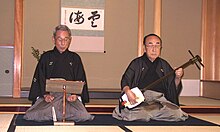Shamisen


A shamisen or samisen (Japanese: 三味線, literally "three taste strings"), also called sangen (literally "three strings") is a three-stringed musical instrument played with a plectrum called a bachi. The pronunciation in Japanese is usually "shamisen" (in western Japan, and often in Edo-period sources "samisen") but sometimes "jamisen" when used as a suffix (e.g. Tsugaru-jamisen).
Construction
The shamisen is similar in length to a guitar, but its neck is much slimmer and without frets. Its drum-like rounded rectangular body, known as a dō, is covered with skin in the manner of a banjo, and amplifies the sound of the strings. The skin is usually from a dog or cat, but in the past a special type of paper was used and recently various types of plastics are being tried. On the skin of some of the best shamisen, the position of the cat's nipples can be seen.[1]
The three strings are traditionally made of silk, or, more recently, nylon. The lowest passes over a small hump at the "nut" end so that it buzzes, creating a characteristic sound known as sawari (This is a little like the "buzzing" of a sitar, which is called jawari). The upper part of the dō is almost always protected by a cover known as a dō kake, and players often wear a little band of cloth on their left hand, to facilitate sliding up and down the neck. This band is known as a yubi kake. There may also be a cover on the head of the instrument, known as a tenjin.
Playing
In most genres the shamisen is played with a large weighted plectrum called a bachi, which was traditionally made with ivory or tortoise shell but which now is usually wooden, and which is in the shape likened to a ginkgo leaf. The sound of a shamisen is similar in some respects to that of the American banjo, in that the drum-like skin-covered body, known as a dō, amplifies the sound of the strings. As in the clawhammer style of American banjo playing, the bachi is often used to strike both string and skin, creating a highly percussive sound.
In kouta (小唄)(short song) and occasionally in other genres the shamisen is plucked with the fingers.
History and genres
The shamisen derives from the sanshin (三線)(a close ancestor from the southernmost Japanese prefecture of Okinawa and one of the primary instruments used in that area), which in turn evolved from the Chinese sanxian, itself deriving ultimately from Central Asian instruments.
The shamisen can be played solo or with other shamisen, in ensembles with other Japanese instruments, with singing such as nagauta (長唄), or as an accompaniment to drama, notably kabuki (歌舞伎) and bunraku (文楽). Both men and women traditionally played the shamisen.
The most famous and perhaps most demanding of the narrative styles is gidayū, named after Takemoto Gidayū (1651-1714), who was heavily involved in the bunraku puppet-theater tradition in Osaka. The gidayū shamisen and its plectrum are the largest of the shamisen family, and the singer-narrator is required to speak the roles of the play, as well as to sing all the commentaries on the action. The singer-narrator role is often so vocally taxing that the performers are changed halfway through a scene. There is little notated in the books (maruhon) of the tradition except the words and the names of certain appropriate generic shamisen responses. The shamisen player must know the entire work perfectly in order to respond effectively to the interpretations of the text by the singer-narrator. From the 19th century female performers known as onna-jōruri or onna gidayū also carried on this concert tradition.
In the early part of the 20th century, blind musicians, including Shirakawa Gunpachirō (1909-1962), Takahashi Chikuzan (1910-1998), and sighted ones such as Kida Rinshōe (1911-1979), evolved a new style of playing, based on traditional folk songs ("min'yō") but involving much improvisation and flashy fingerwork. This style - now known as Tsugaru-jamisen, after the home region of this style in the north of Honshū - continues to be relatively popular in Japan. The virtuosic Tsugaru-jamisen style is sometimes compared to bluegrass banjo.
One contemporary shamisen player, Takeharu Kunimoto, plays bluegrass music on the shamisen, having spent a year studying bluegrass at East Tennessee State University and performing with a bluegrass band based there. Another player using the Tsugaru-jamisen in non-traditional genres is Michihiro Sato, who plays free improvisation on the instrument. The Japanese American jazz pianist Glenn Horiuchi played shamisen in his performances and recordings.
Kouta (小唄) is the style of song learned by geisha and maiko. Its name literally means "small" or "short song," which contrasts with the music genre found in bunraku and kabuki, otherwise known as nagauta (長唄) (long song).
Jiuta (地唄), or literally "earthen music" is a more classical style of shamisen music.
External links
- Buy Shamisen and Other Traditional Japanese Instruments
- Chie Hanawa and her Shamisen at the Penang Island Jazz Festival 2005
- About Shamisen
- Buy Shamisens and Shamisen Accessories
Audio
- Listen to a shamisen
- Listen to arrangements with shamisen of nagauta pieces Kokaji, Tsurukame, Echigo Jishi and Musume Dojoji
Video
- Shamisen Player - Public Performance #2
- Shamisen at concert
- Shamisen Player - Public Performance
- Tsugaru-Jamisen Player
